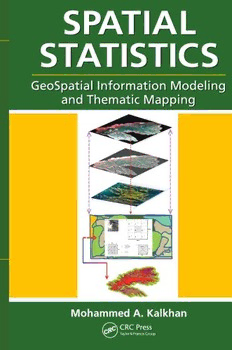Table Of Content69764_cover 3/23/11 3:23 PM Page 1
C M Y CM MY CY CMY K
GEOSCIENCES K
a
l
k
h
SPATIAL STATISTICS a
n
GeoSpatial Information Modeling and Thematic Mapping
Geospatial information modeling and mapping has become an important tool
for the investigation and management of natural resources at the landscape
scale. Spatial Statistics: GeoSpatial Information Modeling and Thematic Mapping
reviews the types and applications of geospatial information data, such as remote S
sensing, geographic information systems (GIS), and GPS as well as their integration
P
into landscape-scale geospatial statistical models and maps.
A
The book explores how to extract information from remotely sensed imagery, T
GIS, and GPS, and how to combine this with field data—vegetation, soil, and
I
environmental—to produce a spatial model that can be reconstructed and A
displayed using GIS software. Readers learn the requirements and limitations of
L
each geospatial modeling and mapping tool. Case studies with real-life examples
illustrate important applications of the models.
S
T
Topics covered in this book include:
A
• An overview of the geospatial information sciences and technology
and spatial statistics T
• Sampling methods and applications, including probability sampling and I
S
nonrandom sampling, and issues to consider in sampling and plot design
T
• Fine and coarse scale variability
I
• Spatial sampling schemes and spatial pattern
C
• Linear and spatial correlation statistics, including Moran’s I, Geary’s C,
S
cross-correlation statistic, and inverse distance weighting
• Geospatial statistics analysis using stepwise regression, ordinary least squares
(OLS), variogram, kriging, spatial auto-regression, binary classification trees,
cokriging, and geospatial models for presence and absence data
• How to use R statistical software to work on statistical analyses and case studies,
and to develop a geospatial statistical model
The book includes practical examples and laboratory exercises using ArcInfo,
ArcView, ArcGIS, and other popular software for geospatial modeling, and is
accessible to readers from various fields, without requiring advanced knowledge
of geospatial information sciences or quantitative methods.
69764
6000 Broken Sound Parkway, NW
Suite 300, Boca Raton, FL 33487
270 Madison Avenue
an informa business New York, NY 10016
www.crcpress.com 2 Park Square, Milton Park www.crcpress.com
Abingdon, Oxon OX14 4RN, UK
Composite
SPATIAL
STATISTICS
GeoSpatial Information Modeling
and Thematic Mapping
SPATIAL
STATISTICS
GeoSpatial Information Modeling
and Thematic Mapping
Mohammed A. Kalkhan
Boca Raton London New York
CRC Press is an imprint of the
Taylor & Francis Group, an informa business
CRC Press
Taylor & Francis Group
6000 Broken Sound Parkway NW, Suite 300
Boca Raton, FL 33487-2742
© 2011 by Taylor & Francis Group, LLC
CRC Press is an imprint of Taylor & Francis Group, an Informa business
No claim to original U.S. Government works
Version Date: 20110720
International Standard Book Number-13: 978-1-4398-9111-7 (eBook - PDF)
This book contains information obtained from authentic and highly regarded sources. Reasonable
efforts have been made to publish reliable data and information, but the author and publisher cannot
assume responsibility for the validity of all materials or the consequences of their use. The authors and
publishers have attempted to trace the copyright holders of all material reproduced in this publication
and apologize to copyright holders if permission to publish in this form has not been obtained. If any
copyright material has not been acknowledged please write and let us know so we may rectify in any
future reprint.
Except as permitted under U.S. Copyright Law, no part of this book may be reprinted, reproduced,
transmitted, or utilized in any form by any electronic, mechanical, or other means, now known or
hereafter invented, including photocopying, microfilming, and recording, or in any information stor-
age or retrieval system, without written permission from the publishers.
For permission to photocopy or use material electronically from this work, please access www.copy-
right.com (http://www.copyright.com/) or contact the Copyright Clearance Center, Inc. (CCC), 222
Rosewood Drive, Danvers, MA 01923, 978-750-8400. CCC is a not-for-profit organization that pro-
vides licenses and registration for a variety of users. For organizations that have been granted a pho-
tocopy license by the CCC, a separate system of payment has been arranged.
Trademark Notice: Product or corporate names may be trademarks or registered trademarks, and are
used only for identification and explanation without intent to infringe.
Visit the Taylor & Francis Web site at
http://www.taylorandfrancis.com
and the CRC Press Web site at
http://www.crcpress.com
Contents
Preface.......................................................................................................................xi
About.the.Author.................................................................................................xiii
1. Geospatial Information Technology...........................................................1
Remotely.Sensed.Data......................................................................................1
Instantaneous.Field.of.View.(IFOV).at.Nadir.
(Resolution.on.the.Ground)........................................................................3
IKONOS.........................................................................................................4
Sensor.Characteristics............................................................................5
IKONOS.Specifications...........................................................................5
ORBIMAGE.(GeoEye)..................................................................................5
OrbView-2.Specifications........................................................................6
OrbView-3.Specifications.......................................................................6
QuickBird......................................................................................................6
QuickBird.Satellite.Sensor.Characteristics..........................................7
The.SPOT.(System.Probatori.d’Observation.de.la.Terre)........................7
SPOT-5.Satellite.Sensor.Characteristics...............................................8
MODIS.(Moderate.Resolution.Imaging.Spectroradiometer).................9
MODIS.Overview..................................................................................10
Technical.Specifications.of.MODIS.....................................................10
MODIS.Land.Products.........................................................................10
ASTER.(Advanced.Spaceborne.Thermal.Emission.
and.Reflection.radiometer).......................................................................13
ASTER.Uniqueness...............................................................................13
History.of.ASTER..................................................................................14
Organizational.Framework.of.ASTER...............................................14
Active.Remotely.Sensed.Data.......................................................................15
Radar............................................................................................................15
Lidar.............................................................................................................17
Lidar.System.Differences.....................................................................18
How.Does.Lidar.Work?........................................................................18
Derived.Remotely.Sensed.Data....................................................................19
Vegetation.Indices......................................................................................19
The.Tasseled.Cap.Transformation...........................................................22
Geographic.Information.Systems.(GIS).......................................................25
Thematic.Data.Layers................................................................................26
Geospatial.Data.Conversion..........................................................................27
Using.ERDAS-IMAGINE.Software.........................................................27
Using.ARCINFO.Software.......................................................................29
v
vi Contents
Select.Area.of.Interest.(Study.Site)...........................................................31
Topographic.Data.......................................................................................31
Global.Positioning.System.(GPS)..................................................................32
GPS.Services...............................................................................................33
The.GPS.Satellite.System.and.Facts.........................................................33
GPS.Applications.......................................................................................34
References........................................................................................................35
2. Data Sampling Methods and Applications..............................................39
Data.Representation.......................................................................................39
Data.Collection.and.Source.of.Errors..........................................................39
Data.Types...................................................................................................39
Sampling.Methods.and.Applications..........................................................40
Sampling.Designs...........................................................................................41
Simple.Random.Sampling........................................................................41
Stratified.Random.Sampling....................................................................42
Systematic.Sampling..................................................................................42
Nonaligned.Systematic.Sample...............................................................44
Cluster.Sampling........................................................................................44
Multiphase.(Double).Sampling................................................................44
Double.Sampling.and.Mapping.Accuracy..................................................45
Pixel.Nested.Plot.(PNP):.Case.Study.......................................................46
Plot.Design.......................................................................................................49
Issues............................................................................................................49
Characteristics.of.Different.Plot.Shapes.................................................49
Plot.Size.......................................................................................................51
What.to.Record......................................................................................51
Issues.......................................................................................................51
References........................................................................................................52
3. Spatial Pattern and Correlation Statistics................................................57
Scale..................................................................................................................57
Spatial.Sampling.............................................................................................58
Errors.in.Spatial.Analysis.........................................................................58
Spatial.Variability.and.Method.of.Prediction........................................58
Spatial.Pattern.................................................................................................59
Spatial.Point.Pattern..................................................................................59
Quadrant.Count.Method.....................................................................63
Linear.Correlation.Statistic............................................................................63
Case.Study...................................................................................................64
Statistical.Example.....................................................................................65
Spatial.Correlation.Statistics.........................................................................65
Moran’s.I.and.Geary’s.C............................................................................66
Cross-Correlation.Statistic........................................................................67
Contents vii
Inverse.Distance.Weighting.(IDW)..........................................................67
Statistical.Example.....................................................................................69
1..Develop.Inverse.Distance.Weighting.............................................69
2..Develop.Moran’s.I.............................................................................69
3..Develop.Geary’s.C.............................................................................71
4..Develop.Bi-Moran’s I.........................................................................73
References........................................................................................................75
4. Geospatial Analysis and Modeling–Mapping........................................79
Stepwise.Regression.......................................................................................79
Statistical.Example.....................................................................................80
Ordinary.Least.Squares.(OLS)......................................................................81
Variogram.and.Kriging..................................................................................83
Ordinary.Kriging.......................................................................................85
Simple.Kriging...........................................................................................86
Universal.Kriging......................................................................................87
Developing.Variogram.Model.and.Kriging.to.Predict.Plant.
Diversity.at.GSENM,.Utah........................................................................87
Model.Cross-Validation........................................................................91
Spatial.Autoregressive.(SAR)........................................................................91
Statistical.Example.....................................................................................92
Using.Spatial.AR.Model.(without.Regression).................................94
Using.Spatial.AR.Model.(with.Regression,.OLS.Model).
Using.R.or.S-Plus...................................................................................94
Example.on.How.to.Develop.Plot.of.Standard.Normal.
Distribution............................................................................................95
Analysis.of.Residuals.for.Plant.Species.Richness.
(gsenmplant).Data.................................................................................95
Weighted.SAR.Model............................................................................96
Binary.Classification.Tree.(BCTs).................................................................97
Cokriging.......................................................................................................100
Geospatial.Models.for.Presence.and.Absence.Data................................104
GARP.Model.............................................................................................105
Maxent.Model...........................................................................................106
Logistic.Regression..................................................................................106
Classification.and.Regression.Tree.(CART).........................................107
Envelope.Model........................................................................................108
References......................................................................................................108
5. R Statistical Package...................................................................................115
Overview.of.R.Statistics.(R).........................................................................116
What.Is.R?.................................................................................................116
Strengths.of.R/S.......................................................................................116
The.R.Environment..................................................................................117
viii Contents
Scripts........................................................................................................118
Working.with.R.on.Your.COMPUTER.................................................118
Begin.to.Use.R..........................................................................................118
Statistical.Analysis.Examples.Using.R......................................................119
Common.Statistics...................................................................................119
Common.Graphics...................................................................................119
Common.Programming..........................................................................120
Create.and.Examine.a.Logical.Vector...................................................121
Working.on.Graphical.Display.of.Data.(Data.Distributions)............121
Develop.a.Histogram...............................................................................122
Data.Comparison.between.the.Data.and.an.
Expected.Normal.Distribution..............................................................122
More.Statistical.Analysis........................................................................124
Reading.New.Variable.(Enter.new.data.set,.WEIGHT)......................124
Plotting.Weight.and.Height....................................................................126
Test.of.Association...................................................................................126
Some.Basic.Regression.Analysis............................................................127
Case.Study.....................................................................................................128
Test.for.Spatial.Autocorrelation.Using.Moran’s.I................................131
Test.for.Spatial.Autocorrelation.Using.Geary’s.C................................132
Test.for.Spatial.Cross-Correlation.Using.Bi-Moran’s.I........................133
Trend.Surface.Analysis................................................................................134
Test.for.Spatial.Autocorrelation.of.the.Residuals................................136
Test.for.Moran’s.I.for.Residuals..............................................................137
Using.Spatial.AR.Model.without.Regression......................................138
Using.Spatial.AR.with.Regression.(Using.All.Independent.
Variables.as.with.OLS.Model)................................................................138
Analysis.of.Residuals..............................................................................140
Develop.Variogram.Model.(Modeling.Fine.Scale.Variability)..........140
Plotting.Variogram.Model......................................................................143
References......................................................................................................143
6. Working with Geospatial Information Data.........................................145
Exercise.1:.Working.with.Remotely.Sensed.Data....................................145
Exercise.2:.Derived.Remote.Sensing.Data.and.
Digital.Elevation.Model.(DEM)..................................................................145
Deriving.Slope.and.Aspect.from.DEM.Data........................................147
Resample.GRID........................................................................................147
Exercise.3:.Geospatial.Information.Data.Extraction................................148
Deriving.SLOPE.and.ASPECT.from.DEM.Data.(ELEVATION)........149
Resample.GRID........................................................................................149
Select.Area.of.Interest.(Study.Site).........................................................150
Data.Extraction.........................................................................................150
Steps.for.Converting.the.Geospatial.Model.to.a.
Thematic.Map.Product............................................................................152
Contents ix
Working.with.Vegetation.Indices.and.Tasseled.
Cap.Transformation.................................................................................154
Vegetation.Indices...............................................................................154
Tasseled.Cap........................................................................................155
Develop.Thematic.Layer.in.ARCVIEW.or.ARCMAP.........................157
VIEWS.(Working.Only.with.ARCVIEW)........................................157
Map.Layout...............................................................................................159
References......................................................................................................160

